Maccheroni alla Chitarra con Ragù d’Agnello
From Abruzzo comes Guitar Cut Pasta with Lamb Ragù
Abruzzo – from the majestic Gran Sasso to its beaches on the Adriatic Sea this part of Italy has postcard perfect terrain. To walk in the mountains of Abruzzo is to walk the age old route of the transumanza – the seasonal sheep migration, and indeed, sheep figure prominently in the socioeconomic history of this region and its cuisine.

Gaetano Alfonso Crocetti
Born 1894 Montesilvano, arrived New York 1913, died 1967 Los Angeles, California
My grandfather, Gaetano Crocetti was born in Montesilvano, Abruzzo. He loved the food of his homeland, and although I have written previously about Ferratelle, the Abruzzese take on Pizzelle, this region has as its most singularly recognizable contribution to Italian cookery an implement known as the chitarra, a tool used to cut pasta. In her book Food and Memories of Abruzzo Anna Teresa Callen writes that this tool appears in manuscripts dating as far back as the thirteenth century.
Indeed la chitarra is part of Abruzzese culture, part and parcel. In dialect it is known as lo carrature or maccarunare. Evenly spaced metal wires are tightly strung along the length of the chitarra. On one side the strings are set farther apart than on the other, enabling the cook to make maccheroni of two different widths.
 Set on a slant in the middle of the chitarra, running lengthwise between the two sets of wires is a wooden board that catches the maccheroni as it falls through the strings. It is simple to use – a sheet of pasta is rolled flat and placed atop the “strings”. A rolling pin (materello) is passed over the sheet of pasta forcing the sheet through the strings, cutting it into noodles. Many homes have more than one chitarra in order that they might make many different sizes of maccheroni. In fact Bart recalls that his Aunt Mary, chief pasta maker of his family, had several, each of which made different sizes of maccheroni. Her husband, Ralph made them for her.
Set on a slant in the middle of the chitarra, running lengthwise between the two sets of wires is a wooden board that catches the maccheroni as it falls through the strings. It is simple to use – a sheet of pasta is rolled flat and placed atop the “strings”. A rolling pin (materello) is passed over the sheet of pasta forcing the sheet through the strings, cutting it into noodles. Many homes have more than one chitarra in order that they might make many different sizes of maccheroni. In fact Bart recalls that his Aunt Mary, chief pasta maker of his family, had several, each of which made different sizes of maccheroni. Her husband, Ralph made them for her.
And about that word, maccheroni – although you will often see pasta made in this manner called Spaghetti alla Chitarra, or Pasta alla Chitarra, the name that is authentic, the name the Abruzzese use is maccheroni. Not to put too fine a point on it, but don’t call it Spaghetti alla Chitarra if you are talking about this kind of pasta with an Abruzzese. They just don’t like it. The name they prefer is Maccheroni alla Chitarra. I have it on the best authority.
You will encounter many different dough recipes for use with a chitarra, but they all have one thing in common – they are quite firm, and thus somewhat more difficult to manage than other doughs. The unique feature of the hearty maccheroni made on a chitarra is the square edges that are formed when the dough is cut by the metal strings. In order to keep those square edges when cooked, the dough must be firm. The doughs can be made with semolina, all-purpose flour, bread flour or a combination. All contain eggs, and some call for salt.
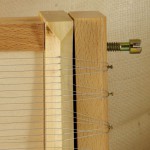 A few words about the care of a chitarra – do not immerse it in water. Do that and you will have to buy a new one. Treat it as you would your pasta machine; a simple dusting off with a brush or towel after use is sufficient to clean this tool. Just as with a musical instrument, over time, the strings will loosen, and you will have to tighten them. When purchasing a chitarra, select one with tuning pegs to tighten the strings. It is important to keep a chitarra tuned because if the strings are not taut, you will not be able to cut the pasta.
A few words about the care of a chitarra – do not immerse it in water. Do that and you will have to buy a new one. Treat it as you would your pasta machine; a simple dusting off with a brush or towel after use is sufficient to clean this tool. Just as with a musical instrument, over time, the strings will loosen, and you will have to tighten them. When purchasing a chitarra, select one with tuning pegs to tighten the strings. It is important to keep a chitarra tuned because if the strings are not taut, you will not be able to cut the pasta.
Maccheroni alla Chitarra con Ragù d’Agnello
serves 4 as a main dish
Ragù d’Agnello – Lamb Ragù
This is shepherd’s food, and it is just as much about the meat as the tomato sauce – it’s all about flavor development, and that comes with browning and reduction. It never pays to rush a ragù.
Some recipes call for ground lamb, but I prefer to chop it in very small pieces. I like the texture of the small chunks of meat in the sauce, rather than the homogenous effect of ground meat. Additionally, many cooks use shoulder meat, but I prefer the milder taste of leg. If you want something other than maccheroni, try this ragù over polenta. It is wonderful.
I used a Mazzoni 2007 Toscana Rosso. This blend of Sangiovese and Merlot lent an intensely elegant base note to this ragù. At table its glorious deep red was cause for conversation and its substantial body made it the perfect accompaniment for this hearty dish.
3 tablespoons olive oil
1 red onion, cut in fine dice
2 carrots, diced
1 rib celery, diced
1 pound lamb (leg or shoulder), trimmed of fat, chopped in 1/4 inch chunks
3 1/2 ounces pancetta, cut in 1/4 inch dice
28 ounces canned whole peeled tomatoes, preferably San Marzano D.O.P.
1/2 cup dry red wine
1 cup chicken stock
1 bay leaf
6 inch sprig rosemary
pinch peperoncino flakes
salt and pepper
mint to finish
Pecorino and Parmigiano at the table
Heat 3 tablespoons olive oil over medium heat in a large non-reactive Dutch oven. Add onions and salt and saute 4 to 5 minutes until translucent, but not browned. Add carrots, celery, pancetta and peperoncino flakes. Saute until vegetables are soft and slightly caramelized, and pancetta has browned a bit, about 10 to 12 minutes. Add lamb and saute until well browned and all liquid has boiled off, about 10 minutes. Add red wine and cook, scraping any brown bits off the bottom of the pan until wine has reduced completely, 5 to 6 minutes.
A wooden spatula drawn across the bottom of the pan should leave a broad, dry trail. If liquid seeps right back and fills in the trail – you’re not there yet. Keep cooking.
Meanwhile break up tomatoes with your hands or scissors.
Add tomatoes and juice, stock, bay leaf and rosemary. Partially cover pot and simmer over medium low heat, stirring occasionally to prevent scorching, until thickened and deeply colored, about 1 3/4 hours. Remove and discard bay leaf and rosemary stem. (The leaves will have fallen off the rosemary stem by this point, are quite soft and pose no threat.) Taste for seasoning.
Maccheroni
This dough is quite firm. Frankly, it has a mind of its own, and I prefer to make it in my food processor and roll it into sheets by machine. Should you wish to make it by hand, you most certainly may. It just takes a bit of muscle.
1 cup semolina
1/2 cup 00 flour
2 large eggs
1/2 teaspoon salt
semolina or flour for rolling
Place semolina, flour and salt in food processor fitted with steel blade. Pulse 3 times to combine. Crack eggs into 1 cup measuring cup and beat lightly.
With processor running, add eggs in a steady stream. Allow machine to run as mixture blends and finally comes together in a ball. If mixture is too dry, you may have to add a bit of water. Process 20 seconds.
Turn dough out onto counter and knead about 3 minutes, until smooth. Form into disk, wrap in plastic and allow dough to rest 30 minutes.
After dough has rested, cut off 1/4 of the dough, keeping the unused portion wrapped.
Roll into sheets 1/8 inch thick either by hand or with a pasta machine.
Place floured sheet of pasta atop strings of chitarra leaving at least one inch between each end of pasta sheet and ends of chitarra strings. If pasta sheet is too long, it will be difficult to roll and cut the ends.
With very firm pressure slowly roll a floured rolling pin back and forth over the sheet of pasta several times paying particular attention to the ends. A quick glance will tell you if the pasta sheet has been cut – if you see the wire peeking through the surface of the pasta, just “strum” your finger across the sheet of pasta and it will finish cutting and fall through the strings onto the board below. If, on the other hand, it appears that the pasta has not been cut, don’t despair.
Just roll across a few more times, and the maccheroni will cut.
Tip the chitarra to the side, and the maccheroni will fall out onto your work surface. Pick up maccheroni, toss lightly with semolina, form into nests, and place on semolina lined towel to dry slightly.
Bring 6 quarts of water to rolling boil. Add 3 tablespoons coarse sea salt. When water returns to the boil add maccheroni. Cook just until done, about 3 minutes.
To serve, spoon a cup of ragù onto the bottom of a warmed pasta bowl. Add cooked maccheroni, top with more ragù and toss. If ragù is too thick, add pasta water, tablespoon by tablespoon tossing after each addition, until desired consistency is reached. Scatter a few mint leaves on top. Serve at once. Pass Pecorino or Parmigiano.
Note: You can click on any picture for a larger image, and to see a slide show with even more pictures!
I have no affiliation with any product, manufacturer, or site mentioned in this article.
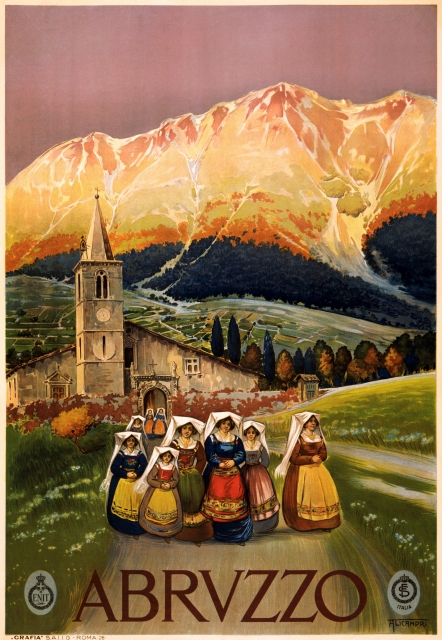
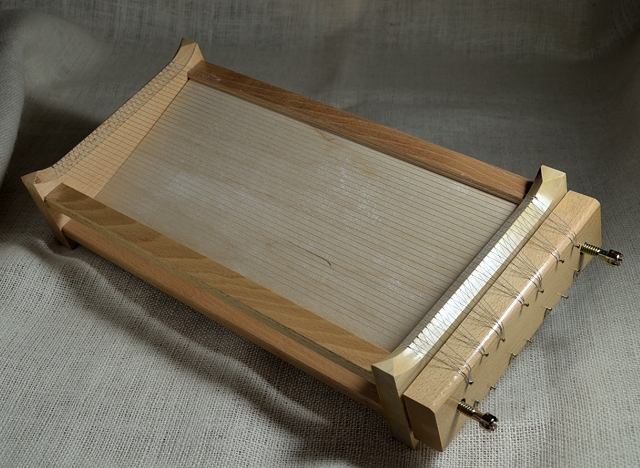
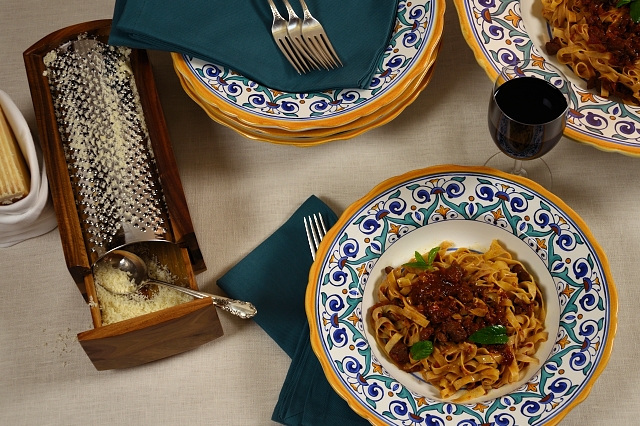
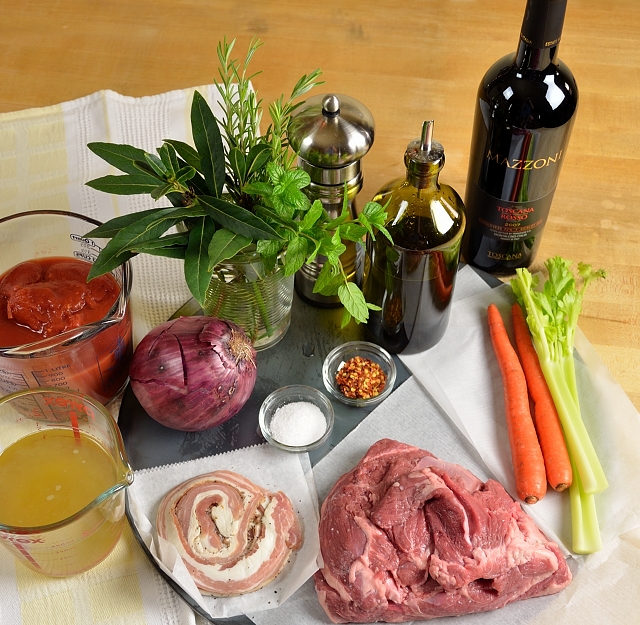
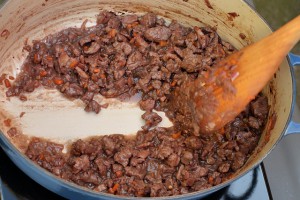
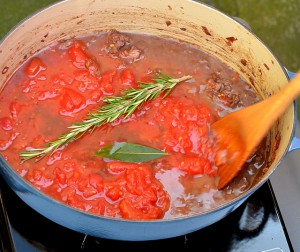

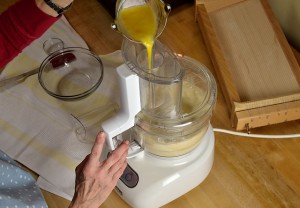



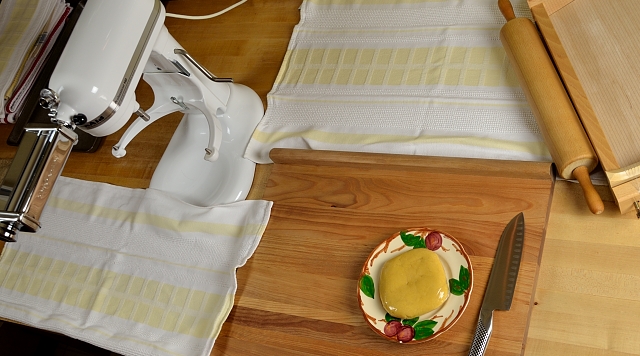



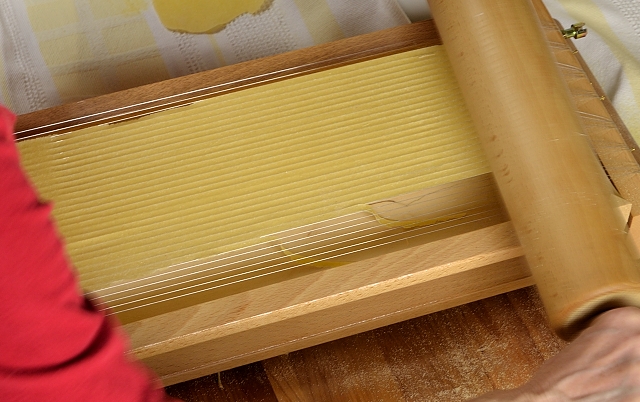


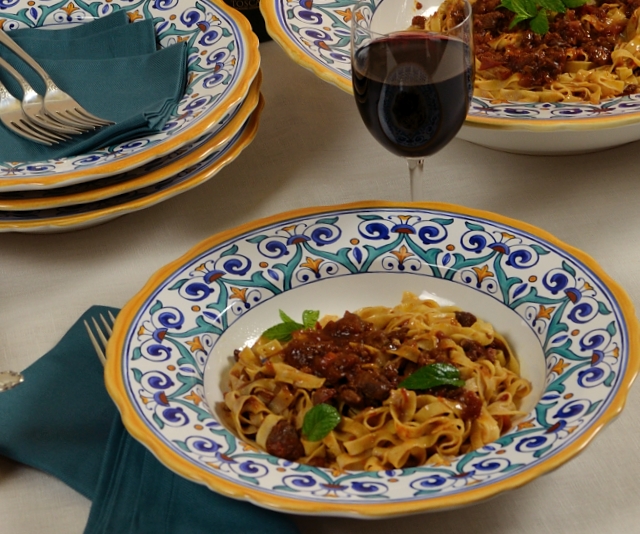

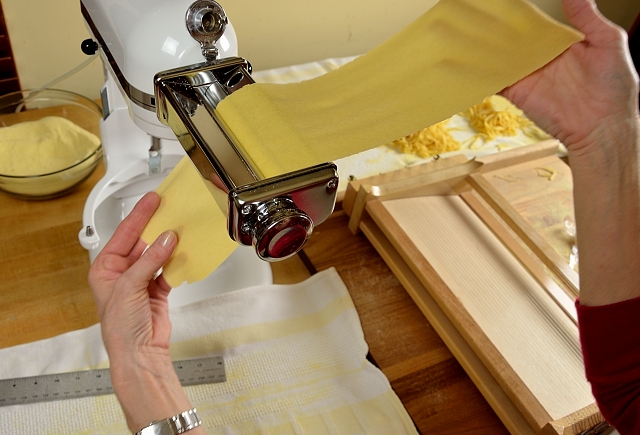
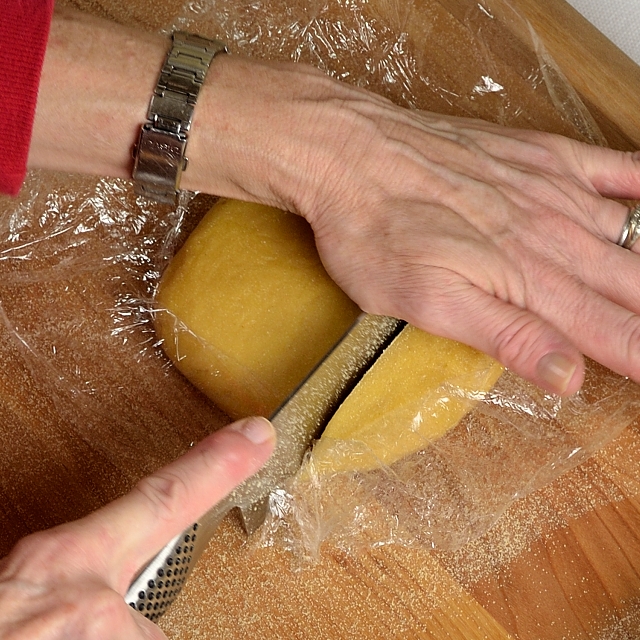

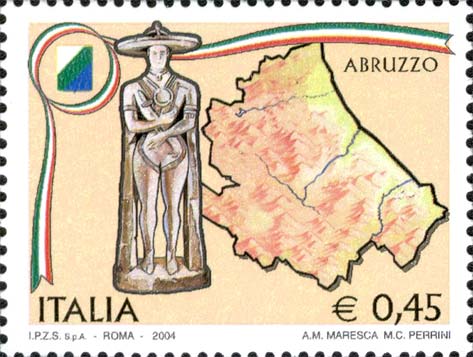

Sunday, November 6th 2011 at 10:58 pm |
This seems perfect for a winter Sunday. Love the Chitarra cutter, BUT… I must know about that cheese grater. It looks terrific, and with a drawer to hold the cheese!
Sunday, November 6th 2011 at 11:14 pm |
This really is perfect for a Winter Sunday dinner. I hope you try it. Let me tell you about the cheese grater. I absolutely love it. It is gorgeous and super efficient. And what you can not see in the photo is a lip at the front of the grater that anchors it to the edge of the table so it does not work its way across the table as you grate. It is from Enrico Products – http://www.EnricoProducts.com Take a look at their site, and thank you for stopping by my site.
Sunday, November 6th 2011 at 11:49 pm |
I love the old poster and the story of your grandfather. Especially, when it’s accompanied by real comfort food like ragu d’agnello.
Monday, November 7th 2011 at 7:11 am |
Thanks so much. I just love the colorful traditional attire. My grandfather was nineteen when he left Abruzzo, and I just can not imagine what it was like for him and all the others of the third great wave of Italian immigrants. Surely it was life’s biggest adventure for them, and life’s biggest gamble. I can be proud of his courage and tenacity. Thanks for stopping by, and I hope you try the Ragu!
Monday, November 7th 2011 at 11:58 am |
Just looking at the photos makes me hungry
Monday, November 7th 2011 at 9:28 pm |
Hi Anthony,
Well, this one will do that to you. It is so homey and tasty – everything you think it would be and and more. I hope you give it try. I bet it will become a family favorite. Thanks for stopping by!
Monday, November 7th 2011 at 4:36 pm |
Adri, I love receiving the posts because the writing is great, the photos are great, and the food is to die for. Thank you.
Ellen
Monday, November 7th 2011 at 9:33 pm |
Hi Ellen, Thanks for the kind words. I had a blast with this one. It really made me think of my grandfather. When I talked to my sister this morning, she said seeing the portrait of Pop (our name for him) made her cry. She added “All he and Dad wanted was for us to be happy.” I had such a nice conversation with her, and all because of this article. I hope you give this one a try when you need something for winter. And if you are not craving pasta, make the ragu and serve it over polenta. It will be wonderful. Thanks for stopping by my site. Come back soon!
Tuesday, November 8th 2011 at 5:16 am |
Adri,
This is so wonderful. The picture of Gaetano Crocetti is magnificent. Thank you for just that alone. What a gift! And the food! Wow! I also love the surprise of movement in one of the pictures. As always, your writing is informative. but so warm. Keep cooking! Janet
Tuesday, November 8th 2011 at 10:23 am |
Hi Janet,
Thanks for the kind words. I bet you would love this ragu – it is perfect for cold weather. If you don’t want to make the maccheroni, just serve it with fettucine or linguine. It is time to install this ragu in the pantheon of Le ricette della famiglia Crocetti. And for the photo – don’t you love the eyes? Both his sons inherited the same eyes, and the same look. It is really remarkable, and until I looked at that photo, I never fully comprehended it. And is that the coolest bow tie you have EVER seen? What a natty dresser he was.
Thursday, November 10th 2011 at 10:03 am |
Thanks Adri for sending me a notice of this post! My grandmother used to make this when I used to visit her in Abruzzo, Loreto Aprutino. It is an incredible coincidence that I tried to make the spaghetti alla chitarra for the first time this Monday! And unfortunately failed, since I had guests and I didn’t want to risk it. I used 90% semolina flour, and I don’t know if that was the issue, but when rolling the sheet onto the chitarra, I didn’t get the impression that the sheet was getting cut deep enough, so after rolling it several times it was just stuck onto the strings and I gave up and used the machine of course with the intention of trying again when I won’t have guests on the day!
of course with the intention of trying again when I won’t have guests on the day!
Thursday, November 10th 2011 at 2:05 pm |
I always look at your wonderful site and shame on me for not commenting on your work. I recall that you made the most glorious bread. It was two beautifully thin layers of dough with cheese in between, and it was really spectacular. I love the coincidence about us both using our chitarre, but I am sorry you did not have success. These doughs are not soft and pliable. I recall making one dough long ago that was so stiff I could not cut it on the chitarra at all. What a disappointment! While one can use any recipe of one’s choosing, as you know, the authentic ones are semolina. I have even modified it. I was taught to use 1 1/2 cups semolina and 2 eggs. The dough has that great texture that really grabs onto the sauce, especially if one rolls it out by hand with a wooden rolling pin on a wooden surface. But that really is work. It is easier for me to use 1 cup semolina and 1/2 cup all-purpose flour. What I sacrifice in authenticity, I gain in ease of production. Also, I have the tendency to roll mine out too thinly. These noodles really ought to be a bit thicker than I make them – what can I say? We certainly enjoyed the maccheroni with the lamb ragu. Well, I think this Sunday it will be more food from Abruzzo – thin crepes filled with cheese set in chicken broth – Screpelle ‘mbusse (Crespelle in Brodo.) It is lovely to hear from you, and I continue to enjoy your site. Thanks for stopping by!
Friday, November 11th 2011 at 8:27 am |
Thanks for sharing! I rolled my sheet quite thick as I wanted them thicker, and I think that’s why I was struggling with it. Next time I will put more flour and roll it thinner. Maybe I’ll have more luck with it I don’t know the ‘Screpelle ‘mbusse’, but from the description they sound lovely! I will be looking forward to your post!!
I don’t know the ‘Screpelle ‘mbusse’, but from the description they sound lovely! I will be looking forward to your post!!
Friday, November 11th 2011 at 3:43 pm |
Hi, It’s great to hear from you again – there seems to be a tipping point with a chitarra – roll the dough too thinly, and the maccheroni is really not “authentic” (great, nonetheless), too thick, and it is altogether unmanageable. I await word on your next attempt. And I would love to have a photo of you maccheroni – to show off another user of the chitarra. Thanks again for stopping by. I love trading info!
Friday, November 11th 2011 at 4:43 am |
This looks so good, and such clear instructions. I haven’t eaten lamb in quite a while, but I’m seeing a lot of great recipes using it lately. I really need to pick some up.
Friday, November 11th 2011 at 3:07 pm |
Greetings Curt, I am glad you found this article informative and clear. I too have seen more recipes for lamb lately. It can be so good and so delicate. I think many people have been put off by having eaten older lamb – that mutton taste is pretty gamey, and for some, just too heavy. I stick with leg, and am always pleased. I hope you try this one. When you do, I would love it if you would send a photo to display in my Readers’ Gallery! Thanks for stopping by my site. I hope you return often.
Monday, November 14th 2011 at 9:51 am |
Ciao Adri!
This post is near and dear to my heart. I love maccheroni alla chitarra, and you’ve done an excellent job of explaining, through words and pictures, how to make this Abruzzese specialty. What a fabulous illustration of Abruzzo at the top of the post. It makes me nostalgic. I’ve been enjoying corresponding with you, and I am so glad to find your blog. Auguri, Domenica
Monday, November 14th 2011 at 6:38 pm |
Hi Domenica,
I am so glad you stopped by my site. I really am honored. Making this one is like coming back home. I only wish “Pop” as we called our grandfather, could be here. He would be so very proud. I just know it. I am glad you like the poster at the top – can you believe how colorful it is? It has been terrific corresponding with you, and you can count on hearing from me as I work my way through The Glorious Pasta of Italy. Thanks for stopping by The Front Burner!
Tuesday, November 15th 2011 at 10:57 am |
That’s a really nice chitarra (Mine is not so elegant) and a first rate discussion of how to make pasta alla chitarra.
Wednesday, November 16th 2011 at 10:47 pm |
Hi Bob,
WOW!! Thank you so much for the very kind words. It is wonderful to hear from folks who are familiar with la chitarra. It is indeed seriously cool, and surely much more than just another gadget. I love mine; you know what they say – you can take the girl out of Abruzzo, but you can’t take the Abruzzo out of the girl! Thank you so much for stopping by my site. I hope you return often.
Friday, November 18th 2011 at 11:51 am |
Adri, this is absolutely fascinating. I love the Chitarra pasta making machine and it is great to see you use it. Talk about putting love and passion into your cooking. Complimenti!! Photos are wonderful too!! You have a real talent for food photos. But I also love the photo of your grandfather Gaetano Alfonso Crocetti — he was certainly handsome, and from the smile in the picture I would guess he was a charming man.
I have left Italy and am spending the weekend in Beirut. I just went to a fantastic Armenian restaurant called Mayrig. Mayrig was apparently an Armenian woman who fled Turkey as a child, was raised in an orphanage in Cyprus and ended up in Beirut where she raised a large family and dedicated herself to cooking. Passion for cooking is clearly something passed down in families. Keep up the great posts! Trisha
Saturday, November 19th 2011 at 8:29 am |
Hi Trisha,
I am so glad you enjoyed the post – I had a blast doing it, and my husband Bart is my photographer in residence. My site has become a joint venture for the two of us, and we enjoy it. The best part, however is hearing from readers who also enjoy it. So thank you very much for writing. The chitarra is a pretty cool tool. It certainly makes a great conversation starter if you are making pasta with dinner guests. It is something lots of people have heard of, but few work with – thankfully with all the cooking mags & TV shows, that is changing.
My grandfather, whom we all called “Pop” was indeed charming, quite a character. He came here with very little, and I am confident he had no idea what the future held for him here. He met my grandmother here and they had two sons, one of whom was a rocket scientist (my dad William) who helped put men on the moon, and the other my Uncle Dean, a celebrated entertainer. The immigrant experience was a rich one for my grandfather and the U.S. was good to the family. He never forgot his homeland, and he always enjoyed the food. My grandmother made sure of that. However it was not until I was much older that I understood how much that food meant to my dad. My only regret is that I did not spend more time in the kitchen with my grandmother.
But Beirut – what a city. Once the garden spot of the Middle East – what is it like now? And the stories the people there have to tell – just look at your restaurant owner. I just can not imagine the lives these folks lead and how really resilient they must be in order to survive and thrive. It must be an honor to met them. As a reporter you have unique access to a world few of us ever see.
Sunday, November 20th 2011 at 3:57 pm |
I sent this post to my cousin in Amsterdam who is an avid pasta maker and he tried it the next day !
Sunday, November 20th 2011 at 5:21 pm |
Hi Kathy,
WOW! How cool is that? Thanks so much for sending it on. As you can see from the number of comments – this one was a hit. I worried that people would find it too much trouble and not even be the least bit interested. Was I ever wrong. I have heard the nicest things about it, and I am so glad to hear from you. I hope your cousin enjoyed it. I had a blast putting it together. I hope all is well with you. Thanks so much for stopping by and for sending it across the sea. Take care, and have a wonderful Thanksgiving.
One more tidbit – are you ready for the family resemblance?
Sunday, November 20th 2011 at 6:22 pm |
I’m new to your blog but so glad I found it. The chitarra is something I’ve wanted for a long time and your instructive post has given me even more incentive. Maybe for Christmas. Great step-by-step and wonderful photos. So nice you included your grandfather’s info. I walked part of the old transumanza this summer. Abruzzo is a treasure.
Sunday, November 20th 2011 at 6:55 pm |
Hi Linda,
Benvenuto! Oh, I am very pleased to hear you enjoyed the article and found it informative. As I said to another reader – I worried people would find the entire process tedious and way too much work. Boy did I ever underestimate everybody! La chitarra is a wonderful tool – and always a great conversation starter for dinner parties! But much more than that it is a link to my family’s past. How wonderful that you walked the Transumanza. You must have had a glorious summer. I am totally envious! I hope you get a chitarra this Christmas. And when you do, please email a photo for my Readers’ Gallery. I would love to see you at work! Til then, have a wonderful Thanksgiving!
Wednesday, February 26th 2014 at 12:13 pm |
Dean and his Grandfather look very much alike. I have 2 friends that make a lot of home made Italian food. You recipes look very tempting. I will give it a try, I can cook, so they might come out! Hope so
Wednesday, February 26th 2014 at 1:11 pm |
Hi Linda,
Yes, the resemblance is unmistakable. There’s no denying this lineage! I hope you give the recipes a try. I think the best way to try something new, or something that is challenging is to do it with a few friends. That way there are always lots of laughs, and it winds up being a great way to learn and explore. Buon appetito, and thank you so much for stopping by.